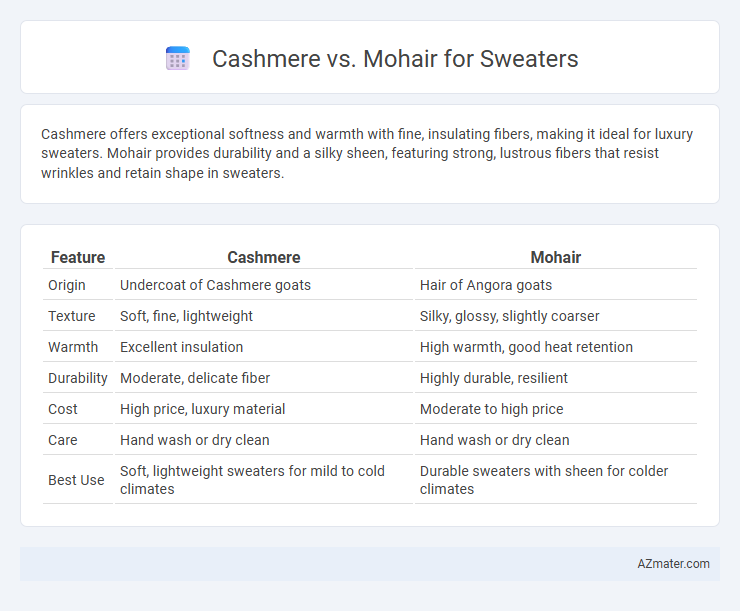Cashmere offers exceptional softness and warmth with fine, insulating fibers, making it ideal for luxury sweaters. Mohair provides durability and a silky sheen, featuring strong, lustrous fibers that resist wrinkles and retain shape in sweaters.
Table of Comparison
| Feature | Cashmere | Mohair |
|---|---|---|
| Origin | Undercoat of Cashmere goats | Hair of Angora goats |
| Texture | Soft, fine, lightweight | Silky, glossy, slightly coarser |
| Warmth | Excellent insulation | High warmth, good heat retention |
| Durability | Moderate, delicate fiber | Highly durable, resilient |
| Cost | High price, luxury material | Moderate to high price |
| Care | Hand wash or dry clean | Hand wash or dry clean |
| Best Use | Soft, lightweight sweaters for mild to cold climates | Durable sweaters with sheen for colder climates |
Introduction to Cashmere and Mohair Sweaters
Cashmere sweaters are crafted from the soft undercoat fibers of cashmere goats, renowned for their exceptional warmth, lightweight feel, and luxurious softness. Mohair sweaters originate from the Angora goat, offering a distinctive sheen, durability, and excellent insulation with a slightly firmer texture. Both fibers provide premium comfort and elegance, but cashmere is prized for its delicate softness while mohair is valued for its resilience and luster.
Origin and Source of Cashmere vs Mohair
Cashmere is derived from the undercoat of Cashmere goats native to the Himalayan regions of Mongolia, China, and India, prized for its fine, soft fibers. Mohair comes from the Angora goat primarily raised in South Africa, Turkey, and the United States, known for its long, silky, and durable fibers. Both fibers are valued in luxury sweaters for their unique textures and insulating properties, originating from distinct goat breeds and geographic regions.
Texture and Softness Comparison
Cashmere offers a luxuriously soft and smooth texture due to its fine, delicate fibers that provide exceptional warmth and comfort without bulk. Mohair, derived from the Angora goat, features a lustrous sheen and a slightly coarser, more resilient texture that adds durability and a distinctive silky feel to sweaters. When comparing softness, cashmere is generally softer and more supple, while mohair provides a unique combination of softness and a lightweight, airy warmth ideal for creating textured, elegant knitwear.
Warmth and Insulation Properties
Cashmere offers superior warmth and insulation due to its fine, soft fibers that trap heat efficiently, making it ideal for cold weather sweaters. Mohair, derived from the Angora goat, provides excellent insulation with a silky texture and natural moisture-wicking properties, which enhances comfort and breathability. While cashmere excels in lightweight warmth, mohair delivers durability and a slightly loftier feel, making both fabrics excellent choices depending on insulation needs.
Durability and Longevity Factors
Cashmere sweaters offer exceptional softness but tend to be less durable than mohair, which boasts higher resilience due to its strong, lustrous fibers. Mohair's natural elasticity and resistance to wear make it ideal for long-lasting garments that maintain shape and appearance over time. Choosing mohair enhances sweater longevity, while cashmere requires more delicate care to preserve its luxurious texture.
Care and Maintenance Requirements
Cashmere sweaters require gentle hand washing with cold water and mild detergent or professional dry cleaning to preserve softness and prevent shrinking, while mohair sweaters benefit from similarly delicate care but often tolerate gentle machine washing on a wool cycle. Both fibers are prone to pilling and should be stored flat in breathable containers away from direct sunlight to maintain their fibers' integrity. Regular de-pilling and air drying flat ensure longevity and keep sweaters made from cashmere or mohair in optimal condition.
Style and Appearance Differences
Cashmere sweaters offer a soft, luxurious texture with a smooth, matte finish, creating an elegant and understated look. Mohair sweaters feature a distinctive sheen and a fluffy, fuzzy halo, lending a bold and eye-catching appearance. The drape of cashmere is more fluid and refined, while mohair provides a slightly stiffer, more voluminous silhouette.
Price and Value Considerations
Cashmere sweaters typically command higher prices due to the labor-intensive harvesting process and the rarity of fine cashmere fibers, offering exceptional softness and warmth that justify the investment. Mohair sweaters, derived from Angora goat hair, are generally more affordable while providing durability, sheen, and excellent insulation, making them a cost-effective choice for luxury knitwear. Consumers should weigh cashmere's premium softness and exclusivity against mohair's affordable resilience to determine the best value based on personal preference and budget.
Environmental Impact and Sustainability
Cashmere production often leads to severe environmental degradation due to overgrazing by cashmere goats, resulting in soil erosion and desertification, while mohair, sourced from Angora goats, has a lower ecological footprint thanks to more sustainable grazing practices. Mohair fibers are renewable and biodegradable, supporting circular fashion initiatives, whereas cashmere demands higher water usage and intensive land management. Choosing mohair sweaters aligns better with sustainability goals by minimizing habitat destruction and promoting responsible farming.
Which is Better: Cashmere or Mohair for Sweaters?
Cashmere offers unparalleled softness and warmth, making it ideal for luxurious sweaters that provide comfort during colder months. Mohair, derived from the Angora goat, is known for its durability, sheen, and natural elasticity, resulting in sweaters with a lightweight yet insulating feel. When choosing between cashmere and mohair for sweaters, cashmere excels in softness and warmth, while mohair provides greater resilience and a distinctive luster, catering to different preferences and needs.

Infographic: Cashmere vs Mohair for Sweater
 azmater.com
azmater.com